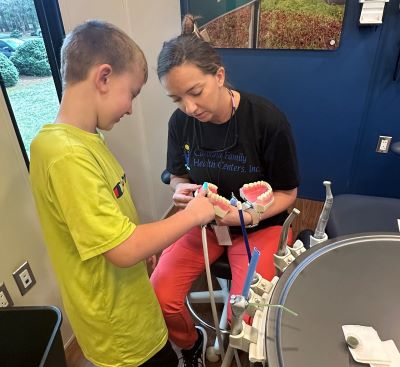Enter your email to receive the CareQuest newsletter:
March 27, 2024
Carolina Family Health Centers, Inc. has provided medical and dental care for patients in three North Carolina counties for years. But during that time, the Federally Qualified Health Center (FQHC) was having trouble accessing a specific part of the population that needed oral health care — children.
“Since I’ve been here, within these nine years, we’ve had a very low pediatric population that we treat here for dental,” says Jessica Ezzell, RDH, a dental hygienist at Carolina Family, which provides care in the northeast corner of the state. “So, it has been a big goal of ours to reach out to that pediatric population and bring them in.”
Carolina Family has been participating in CareQuest Institute for Oral Health’s Community Oral Health Transformation (COrHT) Initiative for the past two years. Ezzell says the initiative helped the clinic reach out to a local elementary school to provide oral health care for its students.
“We worked with the onsite school nurse and principal to set up dates and times that we could come to the school that worked best with the students’ schedules,” Ezzell said. “And we took our dental unit — our bus — out there to their parking lot and set up. We walk the students from their class in small groups to the dental bus to have their screenings and get some dental education before returning them back to class.”
Improving access to care for children was just one track of the work Carolina Family Health Centers did as part of COrHT. They also focused on the transition to value-based care and increasing the use of minimally invasive care for patients.
“We were able to incorporate caries risk assessments, periodontal risk assessments, and oral cancer screenings and assessments for patients,” says Hilary Patterson, DMD, the chief dental officer at Carolina Family. “And we documented those accurately with the help and guidance of our coaches and team members with COrHT.”
Incorporating Value-Based and Minimally Invasive Care
Patterson says the clinic took CareQuest Institute’s Value-Based Care (VBC) Readiness Assessment as a starting point of COrHT to evaluate organizational readiness to transition to a value-based care and payment model in dentistry.
“On our medical side, we have been slowly transitioning to value-based care with insurance and with patients,” Patterson says. “We have seen growth of a department focused on population health with care coordinators who work with patients directly to improve those quality measures. And I think overall it has been a transition from sick care to a goal of health care.”
Carolina Family also focused on using minimally invasive care as an option for patients. Through COrHT, the clinic discovered a significant increase in primary and secondary prevention procedures, from fluoride varnish applications to nutritional counseling.
“We added silver diamine fluoride to our armamentarium,” Patterson says. “We also saw a decrease in surgical intervention over the past year and a half, which shows that we’re improving the oral health of our patients.”
The Need for a School-Based Oral Health Program
Through COrHT, Carolina Family was also able to meet with other dental offices to gain some knowledge and guidance about starting their school-based oral health program.

“Our monthly coaching calls gave us a lot of information and kept us motivated even when it was taking such a long time to get approved to get into the school systems,” Ezzell says. “And then also the funding. Without the funding, we wouldn’t have been able to get the supplies and everything we needed to get the bus up and running for the screening event at the school.”
Ezzell says dental education is low or lacking in the pediatric population in the counties Carolina Family services, and getting oral health care for their children is challenging for parents.
“For parents, it’s a big issue with transportation or taking time off of work to bring their children into the dentist,” Ezzell says. “For us to be able to take our dental bus to them to offer these services, or even offer transportation for them to bring their children to us, has been a big help in getting these children seen and treated.”
And the FQHC hopes to help even more than the 400 students they’ve seen at the local elementary school.
“With our future plans, if we’re able to grow our team, we can hopefully grow into more schools nearby and see more of the pediatric population,” Ezzell says.
To learn more about Carolina Family’s participation in COrHT and their school-based program, watch this video.